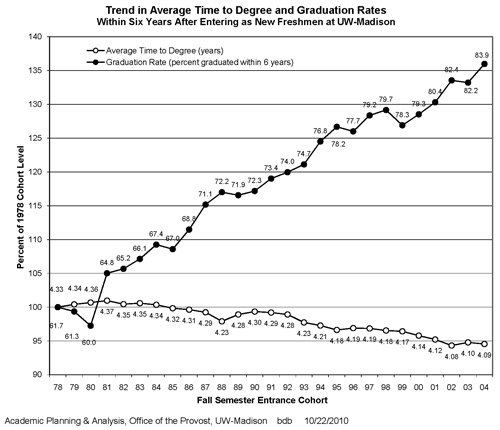This may not be the case at all universities, but we suspect the trend is occurring at other institutions of higher learning. At the University of Wisconsin-Madison, data from Chancellor Biddy Martin's office reveals that it is taking students less time, not more, to get their diploma. In a study looking at all freshman students enrolled at the University since 1978, research shows that the time needed to complete a degree took 4.33 semesters in 1978 and peaked at 4.37 in 1981. Since then, there has been a gradual drop - a positive trend - in the time needed to obtain a diploma. In 2003, it took students 4.1 semesters to get their degree. In calculating this trend, the UW team looked at students six years after entering the University.
Making this trend more impressive is the fact that more students are actually graduating. Going back to 1978, only 61.7 percent of students were earning diplomas six years after entering the school as freshman. That rate bottomed out in 1980 when only 60 percent got a degree. Since then there has been a steady gain in graduation rates which peaked at 82.4 percent in 2002.

So why is it taking students less time to get a degree when most conventional wisdom says that it is taking longer? We have two theories.
1. More students are coming to the universities with Advanced Placement (AP) courses. These AP course transfer directly from high school to college transcripts.
2. As tuition costs go up, students are taking more courses each semester. College isn't cheap, so get done as quickly as possible is the new trend. College judging team coaches confirmed this notion at World Dairy Expo, noting it is getting more challenging to find times to practice with their judging teams as course loads get more demanding.
Making this trend more impressive is the fact that more students are actually graduating. Going back to 1978, only 61.7 percent of students were earning diplomas six years after entering the school as freshman. That rate bottomed out in 1980 when only 60 percent got a degree. Since then there has been a steady gain in graduation rates which peaked at 82.4 percent in 2002.

So why is it taking students less time to get a degree when most conventional wisdom says that it is taking longer? We have two theories.
1. More students are coming to the universities with Advanced Placement (AP) courses. These AP course transfer directly from high school to college transcripts.
2. As tuition costs go up, students are taking more courses each semester. College isn't cheap, so get done as quickly as possible is the new trend. College judging team coaches confirmed this notion at World Dairy Expo, noting it is getting more challenging to find times to practice with their judging teams as course loads get more demanding.








